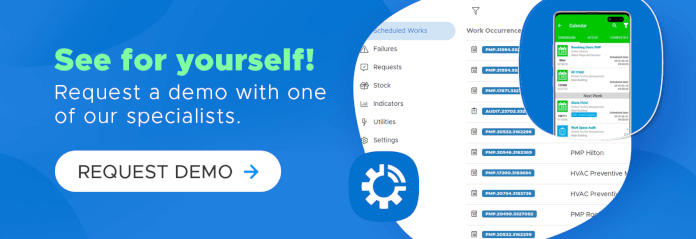Nowadays, everyone and their dog has heard about predictive maintenance. But not a lot of people have full-fledged predictive strategies in place. If you’re in this group, you may still wonder whether or not predictive maintenance is really cost-effective. Will you get your investment back?
The benefits of predictive maintenance
You probably heard all about the benefits of predictive maintenance before. But we promise we have a point here! It’s too easy to fall down the “cost of predictive maintenance” vs “cost of reactive maintenance” rabbit hole. Nevertheless, we cannot measure cost-effectiveness just by taking into consideration the cost of maintenance itself.
Predictive maintenance eliminates downtime.
Reactive maintenance comes with high costs and it doesn’t avoid downtime. If predictive maintenance can eliminate hours of downtime, it might pay for itself with higher outputs and reliability. As an example, here’s the average unplanned downtime in the Oil and Gas Industry:

Source: Oden Technologies.
Predictive maintenance extends asset lifespans.
When you’re able to detect failures accurately and avoid breakdowns, even older assets become more reliable. That means you can get more return on investment per each piece of equipment.
Predictive maintenance avoids waste.
Research found that 30% of time-based preventive maintenance is unnecessary, which creates waste. (We’re sorry to give you the news.) If predictive maintenance avoids this, how much time and resources can you save?
Predictive maintenance is not intrusive.
Would you sign up for a medical check-up if that put your life at risk? Sometimes, preventive maintenance requires disassembling and reassembling activities, which increases the likelihood of a breakdown in the future and the costs that come with it.
Is predictive maintenance cost-effective?
As tempting as it all sounds, the question still lingers in the air. Is predictive maintenance really cost-effective? As any maintenance manager knows, most condition monitoring techniques – a non-negotiable condition for predictive maintenance – still come with high upfront costs. And then there’s still the cost of data modelling and analysis. For a lot of companies, it may be prohibitive. So one wonders if predictive maintenance is the oasis in the desert we all want it to be.
We set out to find the answer. According to a widely quoted McKinsey study published in 2018, predictive maintenance can improve maintenance efficiency and generate “substantial savings” in more ways than one:
- It reduces maintenance costs by 18-25%.
- Increases availability by 5-15%, which yields even more gains.
That same year, PWC released a report called “Predictive Maintenance 4.0 – Beyond the Hype: PdM delivers results”. The study surveyed 268 European companies from Belgium, Germany, and the Netherlands. It focused on how we move on from visual inspections to instrument inspections, real-time condition monitoring to the promising new world of real-time big data analytics (PdM 4.0).
Once again, the study suggested predictive maintenance is cost-effective for manufacturers:
- Companies decreased maintenance costs by 12% (less than in the McKinsey study, which pointed to 18-25%) and availability improved by 9%.
- Predictive maintenance also extends the lifetime of an aging asset by 20%.
- Reduced safety, health, environment and quality risks by 14%.
Both studies prove that predictive maintenance allows:
- more targeted maintenance (less wasteful repairs and inspections);
- predictable quality and improved reliability;
- better overall effectiveness (OEE);
- longer asset lifespans.
The plot thickens: how much does equipment downtime cost?
Another 2018 report by the CXP Group showed that 91% of businesses see a reduction in repair time and unplanned downtime, and 93% see improvement of aging infrastructure. Whether or not that means a positive return on investment depends on (1) how much those repairs would cost and (2) how much companies lose with unplanned downtime, but they’re undoubtedly promising statistics.
While we were trying to answer that question, we found a 2016 report by the Aberdeen Group. The report suggests that, at the time, unplanned equipment downtime cost, on average, $260.000 an hour (a 60% jump from 2014.) And how long does the average outage last? According to Machine Metrics, around 4 hours. Now, that’s a massive amount: $1.040.000 per outage on average! If only maintenance could prevent it…
But those are just average values and statistics, right? Surely your company is not losing around a million dollars (around £725.500) every time a machine goes out of service. So, how much does downtime cost your company? Start by calculating containment and repair costs. Then calculate the output you lost and what it represents in terms of revenue. Add any other costs you might incur (compensation to third parties, etc), and sum it up.
These are not easy (or pleasant, for that matter) calculations. However, it’s absolutely necessary to assess how much you risk to lose every year. It gives you a threshold for how much you can invest and how soon you can expect return on investment. However, if you want to be thorough, we did some extra digging for you.
What’s the value of predictive maintenance?
Knowing how much downtime and repairs cost is a good start. If the cost of reactive maintenance is the same, then you won’t be saving anything. Now, when you’re comparing preventive and predictive maintenance, the choice isn’t as straight-forward.
Predictive maintenance is more targeted, but it isn’t foolproof. How accurate is it? What’s the likelihood of predicting failures? And can you predict them with enough time? Packt has a tutorial so that you can do some modelling:
Net Savings = (Cost of Failure * [Expected Number of Failures – Expected True Predictions]) – (Proactive Repair Cost * [Expected True Positives + Expected False Positives])
Is predictive maintenance cost-effective? Everything points to a solid “yes”, at least in manufacturing. Is it worth the investment for your company? When can you expect a return on investment? Monitor your key performance indicators, investigate condition-monitoring techniques, and do some math of your own.



